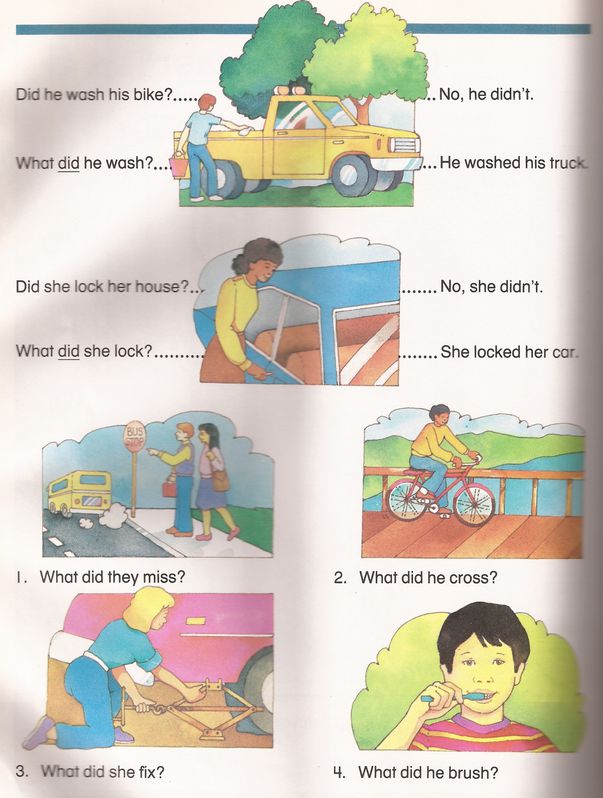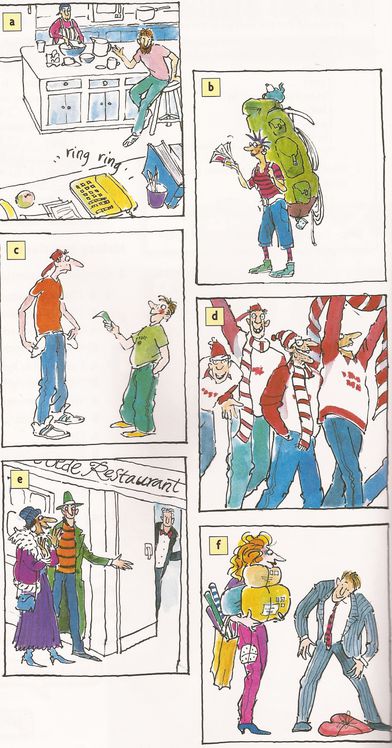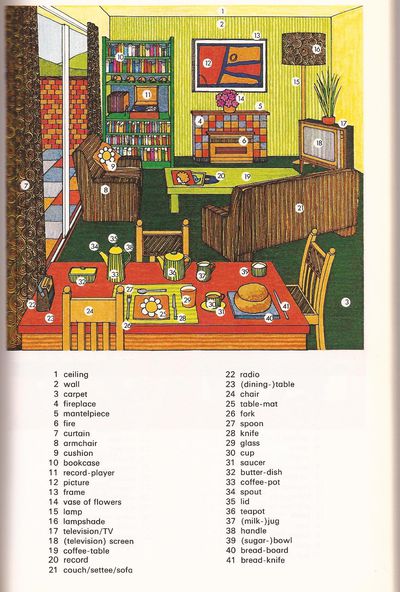El propósito de este artículo es simplemente familiarizar a los estudiantes que siguen este curso, con las partes del habla en Inglés e informarles acerca de algunos términos adicionales de gramática, los mismos que son necesarios para comprender más claramente las lecciones y los ejercicios que se brindan en este espacio.
Sugiero a quiénes me estén siguiendo en este curso básico, que los ejercicios que brindo en esta sección como parte de la sintaxis inglesa, sean pensados, razonados, elaborados e internalizados paralelamente con la parte teórica gramatical de las lecciones y los ejercicios aquí brindados.
PARTES DEL HABLA
1) Los Sustantivos
Un sustantivo es el nombre de algo. Puede ser el nombre de algún objeto concreto como: libro, mesa, dinero
book - table - money
También puede ser el nombre de un objeto abstracto como: honor, energía, amor
honor - energy - love
a) Sustantivo Común
Un sustantivo común es el nombre de algo común a todos los miembros de una comunidad, como por ejemplo: ciudad, río, bote, clase, calle, auto, etc
city - river - boat - class - street
b) Sustantivo Propio
Un sustantivo propio es el nombre especial de una persona, un objeto o un animal, como por ejemplo: Chicago, Buenos Aires, Mexico, Rosa, Pedro, etc.
Chicago - Buenos Aires - Mexico - Rose - Peter
Los sustantivos propios en Inglés siempre se escriben con mayúscula.
Elige, señala o marca los sustantivos comunes y propios en las siguiente oraciones:
- John is a good boy
- The book is on the talbe
- He has no money
- Helen lives in Santiago
- The Hudson is a large river
- The men were late for the party
- The door es open
- Mr. Smith is our teacher
- I met John on Fifth Avenue
- The sun is in the sky
EJERCICIOS PARA PRACTICAR INGLES
(LOS PRONOMBRES PERSONALES)
I) Escribir la traducción de los pronombres personales:
I =
You =
He =
She =
It =
We =
You =
They =
II) Unir con flechas:
Yo They
Tú You
El We
Ella You
Eso (ello) It
Nosotros He
Ustedes I
Ellos She

Por: Carola Pozo Cortez
Como hé mencionado en algún otro post, LOS ADVERBIOS nos indican algo mas acerca de los VERBOS.
LOS ADVERBIOS hacen más interesantes a las oraciones. Como en los ejemplos siguientes:
ADVERBIO DE LUGAR : WHERE
- The children sat in the schoolroom
- I traveled to Paris
- They went to the cinema
ADVERBIO DE TIEMPO: WHEN
- The teacher arrived late
- We went to the part early
- My teacher came quickly to the school
ADVERBIO DE MODO: HOW
- Anne wrote on her slate neatly
- My brother speaks French well
- If I want to travel to Japan, I should work hard
Formation of Adverbs
1) Many adverbs in English are formed by adding - ly - to the corresponding adjective.
fast - fastly
beautiful - beautifuly
quick - quickly
2) However, there are, many special adverbs with no corresponding adjective forms: soon, here, there, often, seldom, ever, never, etc.
3) Some words, like fast, hard, late, early, etc., may be used both as adjectives or as adverbs without any change of form.
He is a fast walker.
He walks fast
He is a hard worker.
He works hard.
EL CASO DEL INFINITIVO
- El Adverbio de modo o de tiempo se coloca después de él:

- Sin embargo los adverbios never (nunca) y always (siempre) se colocan antes de él:
I promised always to tell the truth
Prometí decir siempre la verdad
EL CASO DEL IMPERATIVO
Recordemos que la forma Imperativa del verbo tiene una significación deORDEN y empieza con el verbo. Observa estos ejemplos:
- Look at me = Mírame
- Close the door = Cierra la puerta
- Study now = Estudia ahora
- En el caso del ADVERBIO, tema de esta lección, diremos que los adverbios de tiempo o de modo se colocan después de él. Ejemplos:
Come regularly! = ¡Ven con frecuencia!
Do it now! = ¡Halo ahora!
Call soon! = ¡Llama pronto!
- Encontraremos una excepción en los adverbios never (nunca) yalways (siempre) que se escriben antes. Ejemplos:
Never do it again! = ¡Nunca lo vuelvas a hacer!
Always call before coming! = ¡Llama siempre antes de venir!
LECCIÓN N° 1
LA ORACIÓN
La oración es un conjunto de palabras que tiene un significado o mensaje completo y coherente, la coherencia en ella incerta le da sentido a la misma.
La oración se divide en Sujeto y Predicado.
El sujeto
Es una palabra o un conjunto de palabras de quién o quiénes se habla en la oración.
El predicado
Se divide en dos: Verbo y Complemento.
El verbo
Es la acción que realiza el Sujeto en la oración.
El complemento
Es el resto de la oración después del verbo, que le dá sentido y mensaje completo a toda la oración.
Ejemplo:
Los estudiantes del colegio viajaron a Bariloche muy contentos
SUJETO VERBO COMPLEMENTO
Así como queda explicitado en idioma castellano, exactamente se procederá a analizar una oración en INGLÉS, es decir, que tambien en INGLÉS la oración se divide en Sujeto y Predicado, con las mismas connotaciones y los mismos significados gramaticales.
Por lo tanto, a partir de esta premisa, convengamos que una oración en INGLÉS, tendrá la siguiente estructura o fórmula:
SUJETO + VERBO + COMPLEMENTO
Para que puedas practicar las preguntas interrogativas con los WH... y responderlas adecuadamente, preparé para tí estos ejercicios, donde deberás practicar los diferentes tiempos verbales:
(I) Responde:
1) Where do you live?
.....................................
2) What do you study every day?
.....................................
3) When does your father work?
....................................
4) Why did they travel to London?
....................................
5) Who was her English teacher?
...................................
6) How many brothers does Susan have?
...................................
7) How often do they go to school?
..................................
8) Who is your best friend?
..................................
9) Which film does she like?
..................................
10) Where is he going?
..................................
EJERCICIO ORACIONES AFIRMATIVAS
(II) Escribe la preguntas mas adecuadas a estas respuestas, como en el siguiente ejemplo:
1) Where did you go yesterday?
I went to the cinema
2) .......................................?
We bought a new car
3) ......................................?
They studied English in England
4) .....................................?
Susan went to Mary's party
5) .....................................?
Tom and Charles played football with some friends
6) .....................................?
I forgot my keys on the small table
7) .....................................?
We will spend our holidays in Canada
8) .....................................?
She is walking around two hours
9) .....................................?
My dog was eating its food
10) ...................................?
She has spoken for three hours
EXERCICIO TIEMPO PASADO
En estos ejercicios se aplican exactamente las mismas consignas que los ejercicios que preceden a esta. Observa con atención las dos primeras imágenes, luego lee las preguntas y las respuestas correspondientes.
Ahora es tu turno, observa las cuatro últimas imágenes, lee las preguntas con atención y respóndelas:
1) ....................................................................................................................
.........................................................................................................................
2) .....................................................................................................................
.........................................................................................................................
3) .....................................................................................................................
.........................................................................................................................
4) .....................................................................................................................
..........................................................................................................................

FUTURO SIMPLE Y FUTURO INMEDIATO
GOING TO AND WILL

Escribe la letra que corresponda a cada dibujo con la oración correspondiente.
| 1) | They are going to watch a football match | |
| 2) | I will pick it up for you | |
| 3) | She is going to travel round the world | |
| 4) | It is OK. I will answer it | |
| 5) | Don't worry. I will lend you some | |
| 6) | We are going out to have a meal |
VERBOS IMPERSOMALES.
THERE IS - THERE ARE
I) Elegir la palabra correcta
- There (is,are) a book on the desk
- There (is, are) three men in the room
- There (is, are) many people in the office
- There (is, are) flowers on the table
- There (is, are) a picture on the wall
- There (is, are) a desk in the room
- There (is, are) a notebook on the desk
- There (is, are) many students in our class
- There (is, are) many windows in our room
- There (is, are) a yellow pencil on the desk
II) Cambiar a la forma negativa
- There is a book on the desk
- There are many people in the room
- There is a blue book on the desk
- There is a table in the room
- There are two flowers on the table
- There are many students in our class
- There are many people in the office
- There is a picture on the wall
- There are three men in the room
- There are many windows in our room
III) Cambiar a la forma interrogativa
- There is a table in the room
- There are two men in the office
- There is a chair in the room
- There is a notebvook on the desk
- There are flowers on the table
- There are many windows in our room
- There are many students in our room
- There is a yellow pencil on the desk
- There are two students in the room
- There is a man in the office
Ejercicios de integración
IV) Elegir la forma correcta
- John (is are) a good student
- How many books (is, are) there on the desk?
- (Is, are) this your book or my book?
- There (is,are) two men in the office
- There (is,are) many students in the class
- I (is, am) busy today
- There are two (mans, men) in the office
- There (is, are) a large desk in the room
- Three (womans, women) are in our class
- How many tables (there are, are there) in your room?
V) Corregir los errores
- There is two books on the desk
- How many chairs is there in the room?
- Is you a teacher or a student?
- Is there many pictures in the room?
- How many windows is there in the room?
- Is the flowers red or yellow?
- My shoes black
- I very busy today
- He very good teacher
- Are there a picture on the wall?
DIVISION DE PALABRAS AL FINAL DE UNA LÍNEA
En este tema es menester aclarar que la preocupación de la separación de sílabas al final de una línea, hasta cierto punto, ha sido superada, con el nacimiento de la computadora y el ingreso de esta (PC) con pié firme en nuestros hogares.
Existen diversos programas (software) que eliminan la preocupación o dolor de cabeza que antes nos ocasionaba toda vez que debíamos escribir una carta comercial en Inglés. Sin embargo, considero que no esta demás, como conocimiento de la lengua, saber cómo se separan las palabras en inglés.
a) Para dividir palabras al final de una línea debe tomar en cuenta que no se dividen sílabas que son partes fundamentales de una palabra; es decir, no se dividen letras que claramente van juntas o estan agrupadas juntas:
Error: plan ted
Correcto: plant ed
b) No es posible dividir una palabra de una sola sílaba:
Error: fe -lt , plac - ed ,
c) No se separa una sílaba que tiene una sola letra:
Error: e - nough , a-gain
d) Se separan todos los prefijos y sufijos
Correcto: real-ly , play-ing , pre-cede
e) Si la última letra de una palabra esta duplicada antes de un sufijo, la letra repetida se escribir+a en la siguiente línea:
bidding = bid - ding
stopping = stop - ping
f) Si alguna otra división no esta claramente indicada, se aconseja hacer lo siguiente: colocarmodel cualquier consonante que se encuentre entre 2 vocales, se separará desde la consonante con la primera vocal, siempre que esta vocal sea corta. Ejemplo:
model= mod - el
pity = pit - y
satin = sat - in
Si la primera vocal es larga, de debe colocar la consonante con la segunda vocal
motor = mo - tor
pirate = pi - rate
later = la - ter
Ejercicios
Separa las siguientes palabras según corresponda:
begging employee
benefit owner
police occurence
policy metal
player meter
pitiful photography
feeling century
excitable hopeful
lovable shield
prefer asked
preferred worshipped
worship
LECTURAS DE CIENCIA FICCION
Por: Carola Pozo Cortez
Luego de haber estudiado la grámatica esencial del idioma inglés, es tiempo de practicar la misma leyendo historias cortas para, de esta manera, incorporar vocabulario nuevo a nuestros conocimientos.
TRADITIONAL TALES
This story comes from the island of Bali, Indonesia. It is about Bawang. Her name means 'red onion'. She is ver weet-tempered, and red onions are sweet, so that is how she got her name.
A BALINESE FOLK TALE
Every wash-day Bawang went down to the river with a basket of clother. One day, as usual, she bathed herself in the fastflowing water, then reached for a sarong to wash. But the basket has disappered!
"Oh no!" gasped poor Bawang. "Mother will be so cross if I have los all our clothes."
Bawang realized she must have placed the basket too near the water's edge and that it had tipped in, so she ran downstream as fast as her feet would carr her, to see if she could find it.
Bawang ran and ra, but still she could not see the Basket. Tired out, She stopped to catch her brfeath. Two fish popped their heads out of the water to see who was puffing and panting so.
"Oh, fish, have you ween my basket of clothes in the river?" she asked.
"No sister, we have not ween your basket," the fish replied.
Bawang ran on, tears running down her cheeks. She saw some frogs sitting on the river bank.
"Oh frogs," sobbed Bawang, "have you seen my basket of clother float by?"
"We regret, sister, that we have ween no basket of clothes, " croaked the frogs.
Bawang ran on further until she saw some crabs sunning themselves by the water.
"Oh, good crabs, please, you must have seen my basket of clothes passing by on the river?"
"No," replied the crabs."We have not seen your clothes; but don't cry so, it's not such a loss. We don't need clothes."
VERBOS MAS USADOS EN INGLES
Ya para finalizar el listado de verbos tenemos:
| VERBO (TRADUCCION) | EN INGLES |
PRONUNCIACION
|
Multiplicar
|
Multiply
|
/Móltiplai/
|
Dividir
|
Divide, split
|
/Diváid, sspléit/
|
Permitir
|
Permit, allow,
|
/Permít, aláu/
|
Aguantar
|
Support, hold, bear
|
/Sopót, jóuld, ber/
|
Molestar
|
Bother
|
/Bódær/
|
Empezar
|
Began, start
|
/Begáen, sstart/
|
Terminar
|
End, finish
|
/End, féinish/
|
Abrir
|
Open
|
/Óupen/
|
Cerrar
|
Close, shut
|
/Clóus, shat/
|
Llamar por teléfono
|
Call, phone
|
/Col, fon/
|
Solucionar
|
Solve, resolve
|
/Solv, resólv/
|
Arreglar
|
Repair, fix
|
/Repér , fix/
|
Funcionar, No funciona
|
Function,work, run, Out of order
|
/Fánshion, Uók, ran, Áut of órdær/
|
Romper
|
Break
|
/Bre:k/
|
Cortar
|
Cut
|
/Cat/
|
Pegar (golpe)
|
Hit, give
|
/Jit, guiv/
|
RECOMENDACIÓN: Si te encuentras en la necesidad de mejorar tus conocimientos de inglés para pasar al siguiente nivel o si necesitas estudiar este idioma para fines específicos, te recomiendo el blog de mi talentosa colega Carola M. Gonzalez:
Answer these questions:
- Which three kinds of animal dis Bawang talk to?
- Why did the fish pop their heads out of the water?
- Where were the frogs sitting?
- Why did the crabs tell Bawang not to cry?
DIAS DE LA SEMANA
| ESPAÑOL | INGLÉS |
PRONUNCIACIÓN
FIGURADA
|
| Domingo | Sunday | Sandei |
| Lunes | Monday | Mandei |
| Martes | Tuesday | Chiusdei |
| Miercoles | Wednesday | Uensdei |
| Jueves | Thursday | Zersdei |
| Viernes | Friday | Fraidei |
| Sabado | Saturday | Sacherdaei |
20 agosto 2011
17 julio 2011
13 julio 2011
10 julio 2011
28 mayo 2011








Buenos días: Estoy sorprendida que esta sección haya sido copiada de una de mis paginas, no una lección sino varias en forma totalmente libre sin pedir mi autorización ni publicar los créditos que me corresponden. Al ser la autora de todo este contenido, tengo los Derechos de Autor y basándome en la Ley Argentina N°11723 que regula la propiedad intelectual, intimo a usted a que borre todo este contenido, caso contrario, me veré en la obligación de tomar los recaudos pertinentes.
ResponderEliminar